This story is an excerpt from ALABAMA FOOTPRINTS Exploration: Lost & Forgotten Stories (Volume 1)
Many people are surprised to discover that they have Alabama Ancestors. If you have a brick wall in your genealogy research, you might try checking the state of Alabama. Many Texas and western states will find their ancestors traveled through and often settled for a time in Alabama and/or surrounding states. (Story continued below)
Mississippi Bubble
Opened for settlement by Congress in 1798, the fertile land near the Mississippi River was a place of frenzied speculation and immigration by the French at an even earlier date, during the time called the Mississippi Bubble in Europe.
France originally owned much of the Mississippi Valley land and sent explorers to search for gold and silver in their vast holdings. The Mississippi Bubble was actually a scheme engineered by John Law, an adventurer from Scotland around 1719. He was an economic theorist and also a friend of the Duke of d’Orleans. John Law established the Banque Gênêrale, a bank with the authority to issue notes. Then a year later he established the Compagnie d’Occident and obtained the exclusive privilege to develop the French territories in the Mississippi River valley of North America. His company, named Compagnie des Indes, monopolized the French tobacco and slave trades. He also took over the collection of French taxes and minting money.
Galloping inflation
Of course, public demand for shares in this potentially lucrative company increased sharply. A share of stock went from 500 to 18,000 lives in a short time which was way out of proportion to future earnings. Law issued 625,000 shares, hoping to merge the Banque Gênêrale with his Compagnie des Indes and retire France’s vast public debt in 1719. A frenzy of wild speculation traveled across Europe and the French government printed increasing amounts of paper money to satisfy it’s creditors because it could be used to buy more shares.
ALABAMA FOOTPRINTS Exploration: Lost & Forgotten Stories (Volume 1)
Galloping inflation resulted and both paper money and the billets dêtot began to lose value. Though settlement never materialized. In 1720, the value of shares plummeted and caused a stock market crash in France and other countries. John Law was blamed and forced to flee France in December 1720. This Mississippi Bubble did create an interest in settlement of the Mississippi Territory while it lasted. Many families can still trace their ancestry back to the French explorers who settled there during this time.
England gained victory
After numerous conflicts in North America, England finally gained complete victory over France in North America in the French and Indian War. In the 1763 Treaty of Paris, France gave up all its holdings on the continent to England. In an effort to prevent the English from fully capitalizing on their loss, France signed a secret treaty with Spain to give their ally French possessions west of the Mississippi River, including New Orleans. France was all too happy to cede Louisiana to Spain considering the financial drain and headaches that Louisiana had given them over the years. The French era in Mississippi’s history ended.
Around the time of the American Revolution, adventurous settlers in the American colonies, anxious to improve their fortunes, started moving to new frontiers. After the Revolution, westward expansion intensified. Some Royalists sought out new territory far away from the fighting and others simply wanted better land than the burned out tobacco fields they’d left behind.
The Mississippi Territory which included the land that would soon become Alabama, was a product of this Great Migration. In 1800 there were only two states west of the Appalachians — Kentucky and Tennessee. In 1820 there were eight, Kentucky, Tennessee, Ohio, Louisiana, Illinois, Indiana, Mississippi, and Alabama. The population of these eight western states had grown from 386,000 persons in 1800 to 2,216,000 by 1820. After the war, Revolutionary War soldiers also received land grants in the new Alabama Territory. Some of these soldiers were too old to settle in the state, but their children benefited from their parent’s service by traveling to the land grants and established farms and plantations. Many of the old soldiers eventually followed their children and are buried in scattered graves across Alabama.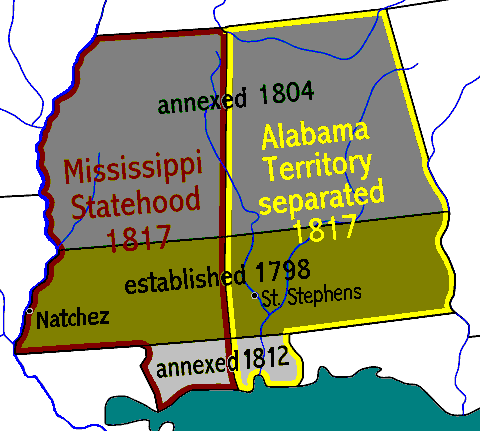
Families tended to be quite large. Early settlers often had a large number of children born in the new state of Alabama, sometimes the number of children from one man was 20 or 30 by several wives. The large families settled on land and frequently raised “white gold”:— cotton. The population of Alabama increased again with the Indian Removal Act in 1830 that opened vast areas of the interior of Alabama for settlement.
Recession drove people west
However, in 1837, cotton prices declined sharply and a collapsing land bubble created by restrictive lending policies in Great Britain caused an economic panic. A severe recession gripped the United States, especially in the south, which forced many people in Alabama to move further west to improve their fortunes. Parents and grandparents often remained behind in Alabama and the Mississippi Territory while their children settled in Arkansas, Oklahoma, and the new republic of Texas. Some followed their children to the new land but many are buried across the state of Alabama. The migration continued for the years 1837 to 1844 as banks collapsed, businesses failed and prices declined. Sometimes, whole communities moved to a new locality often led by a minister or leading citizen. Many large farms and plantations were thrown out of cultivation in Alabama and never recovered.
Civil War caused a population shift
Around the time of the Civil War, another major shift in population occurred. Prior to the Civil War, settlers moved west to get away from the fighting. After the war, many returned home to destroyed farms, plantations and a dismal life during reconstruction in Alabama so they left for the west and a better future. Some traveled as far away as California and Alaska, in a search of gold.
With the number of adventurous people traveling to and through Alabama over a span from 1719 to 1900, there is a good possibility that your ancestors may have spent time in little time in the state of Alabama and it would behoove genealogy researchers to check out the 1850 – 1900 census for the state of Alabama. Children’s names were included in the 1850 census and an elusive ancestor could be found in one of the large families settled during this time in Alabama.
*Note: The photograph attached to this article is of the Splawn & Pratt family of Bibb County, Alabama
L to R Front Aunt Neph Johnson, Aunt Mary Jane Harpole, Grandmother Cruise (lived 99 1/2 years), Aunt Sally Splawn;Back: Uncle Dove Cruise, Aunt Anna Pratt, Ollie Cruise Weaver, Uncle Willis Cruise
WHERE DO I START? Hints and Tips for Beginning Genealogists with On-line resources


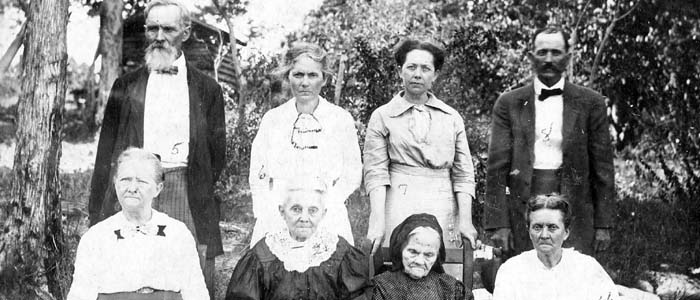

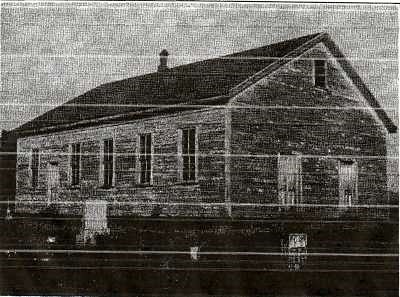
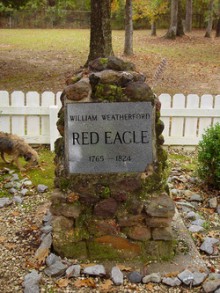
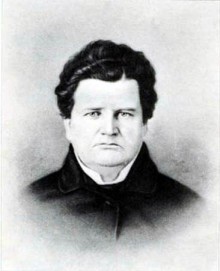
Donna Causey,………… My maiden name is Morrison and my paternal grandmother’s maiden name was Causey!!
If your Causey’s are from around the Montgomery, Alabama area, then we might be related.
Many of my ancestors on my father’s side are listed in “Early Settlers of Alabama.” On my mother’s side, some Henry and Skinner ancestors were in Perry County, having migrated from Elbert Co., GA, and who then moved on ending up in northern Texas.
Law’s Landing , a short distance from John Gunter’s Landing, was in operation at a very early date. Michael Ditto married one of the Law daughters- see Ditto Landing. Many of our Marshall County families have Law family connections. Law’s Landing saw action during the War Between the States as well. Roman’s Landing also was in the same area early. Both landings contributed to the settling of Gunter Mountain (Grant). Old Union Cemetery at Grant is the final resting place for many of the Law and Romans families. Great article! I assumed our Law families were of German ancestory in this area. I will see if I can find a connection with John Law! Thanks!
I believe one of my ancestors was married to a Ditto. Stephen Duke married Sarah Ditto. I am interested in learning more about these Dukes. Their older children were born in Kentucky; younger ones in Alabama. It was an aha moment when I realized that “Ditto” didn’t mean the surname was the same as the one above it!
My relatives were Maddox’s on my father’s side, Dean’s on my mothers side. I understand they traveled down the eastern coast from North Carolina on to Georgia then to Alabama. This is great, interesting information about Alabama’s history regardless. Enjoying reading Alabama Pioneers!
many of my ancestors are from and still are in alabama. jenkins, chadwick, green, fuller, dr. james briscoe dunn. all around the seale, ala. area, phenix city, too. my first cousin was the infamous policeman from the phenix city story, albert fuller.
I have more cousins in Texas than any other state. 🙂
This is so true I have found kin at one time or another in 20 different states.New Mexico I guess was a surprise
I was surprised when my mother told me one of her uncles lived in New Mexico. I guess Texas to New Mexico isn’t such a surprising move, though. The rest of the family went to Oklahoma, but he went to New Mexico.
We have ancestors that settled in Texas, Okla. and NM. Some were Texas Rangers and 1 was a sheriff in NM. shot in the back in the 1870’s .
I need yo check into this!
Most all of my relatives came from Alabama. Daddy’s father’s side (Likely/Golikely & Thigpen) from Covington & Coffee Counties. They traveled West to Texas in the 1870s along with several other related families including the Baileys. His mother’s side (Ridley & Dame) came from Jackson County up near TN/GA boarder. Always interesting to see information on how they lived their lives.
I have a cousin married to a Thigpen,they live inTyler, TX. James Thigpen I am Kathleen Jasmin
yes I do
I think these dear folks have just learned the NASCAR races are on a TV channel that’s not in their cable package.
Almost every branch that we have researched in our family’s genealogy has had at least one person to migrate to Texas.
One of my Ancestors left Tallapoosa Co on wagon train going to Texas she met a man on train she married.She wrote home I left Al a Indian now I’m a white woman.This has puzzled me.
Joshua Brunson, my ancestor, came to Alabama from SC through Georgia. Last child, Abdullah, was born in GA. They were in AL by 1807 in the Madison Co area (somewhere near where present day Huntsville now is). Would appreciate information on his son Matthew and wife who died before 1837. Their son, Joshua, born 1820 left AL in 1837 and took 10 years to migrate to Texas. The “Matthew” generation leaves a lot of unanswered questions for me. The 1837 recession may explain why the younger Joshua and his bride left for Texas. Any information or leads you may be able to provide will be greatly appreciated.
I was born and raised in Alabama……would like to find my Dad”s people as he was orphaned at an early age….his last name is Dotson…..
All my Great Grandparnts on my father’s side (Leftwich and Drake) came from the area around Huntsville and Russellville and my Great Grandfather (Farris) came from around Guntersville (Red Hill). My wife and I work on the Drake Cemetery in Franklin County when we come to Alabama.
My Dad’s parents were from the Tri Cities area in Alabama…..Muscle Shoales,Florence and Tuscumbia…..last name of Dotson…..if anyone has information on this family please contact me…..
Doing research of my ancestors, I found that many who migrated from their homes in Alabama
just deserted them, painted on the outside walls, “GTT”, found out that stood for “Gone To Texas”.
My grandfather, M. A.Melvin (1837-1902), lists Alabama as his place of birth, with his father having been born in Scotland and his mother in Ireland. This was in the 1870 census and the 1900 census I have not been able to find him listed in any census before 1870, at which time he was living in Mississippi. He ended up in Midway Texas, where he died in 1902. I have searched for years, trying to find a record of any kind for him in Alabama, and so far, no luck in that or in finding names for his parents.
I suppose I do not understand moderation.
Mine did in Blount county. for many years.
I’ve never seen one, but I’ve been told that there are memorials in some cemeteries in Alabama that are engraved with a name, date of birth and GTT (Gone to Texas) instead of a date of death.
Yes they do Sir name Tyra (among other spellings of this name.)
In practically every family branch I’ve researched, people moved to either Texas, Arkansas, or Oklahoma. My own gg-gf went to Smith Co, Texas with other family members in 1892. If his wife hadn’t been so homesick for Marshall Country and the Tennessee Valley, I never would’ve been born!
I found that each generation moved a little further down the east coast and headed west at end of Appalachian Mtns. Crossing the mountains wasn’t easy in those days and you were isolated from your family. Therefore many came through Ala.
I understand Lady Bird Johnson’s family robbed the train in Alabama before leaving for Texas….any idea if this is true????
I found a whole new family both deceased and living in Alabama!! My families the Hurley and Edwards family came from Alabama
I am one of these people!!!
My Paternal Grandmother actually came from Paris, Texas to Alabama.
Me too
Came to Texas after the civil war. They lost everything in Alabama.
My great great grandfather came to Texas with his family from Pike County Alabama by wagon train in 1864.
Donna Causey, Thank you so much for all of your effort and hard work on the history of Alabama.
I have ancestors from both sides of my family with deep roots in Alabama that migrated to Texas.
(GTT)
Very Early Alabama Pioneer Ancestors
Fathers side: Adam Harrell my 2nd GGF. Mothers side: David Lindsey my 5th GGF
Coosa County Alabama Ancestors
Fathers side: Thomas M. Weaver my GGF. wife: Martha Jane Harrell my GGM.
My Weaver Ancestors moved to Smith County TX. before the Civil War
Shelby County Alabama Ancestors
Mothers side: Amos “Stump” Elliott my 2nd GGF. wife: Nancy Hale my 2nd GGM.
My Elliott ancestors moved to Kaufman TX after the Civil War.
In Tuscaloosa County and Fayette County they painted o9n the doors of their residence
“GTT” which stood for “Gone To Texas”.
Mary Ann Clayton look at you great grandmother in the picture.
I was born in Anniston AL 08/31/1940 . May father was Charles Adams Rice from New Hope AL and my mother was Lenore Jane Formby Rice from Anniston. My dad said our heritage was Scotch-Irish.
Thank you for the history!!! I really appreciate “Alabama Pioneers” and the work you do on this site…..The reasons for family moves from one state to
another is an integral to reserching genealogy. My grgrgrandmother was from Coosa AL.
Elizabeth Jane Coker. (born 1826, d 1906) Married John M Blalock (from GA) in Autauga , AL, 1847 then they moved to MS, then AR, then OK…She is buried close by and my future grave is close to hers!
my great grandmother was married to james coleman tharp, who is descended from hezekiah tharp and nancy colbert, daughter of chief george colbert. My great grandmother was born in cherokee alabama and they had one child, a daughter, virginia isabel tharp vaughn, having married william washington vaughn. Does anyone know anything about the tharp land around cherokee or russellville alabama?